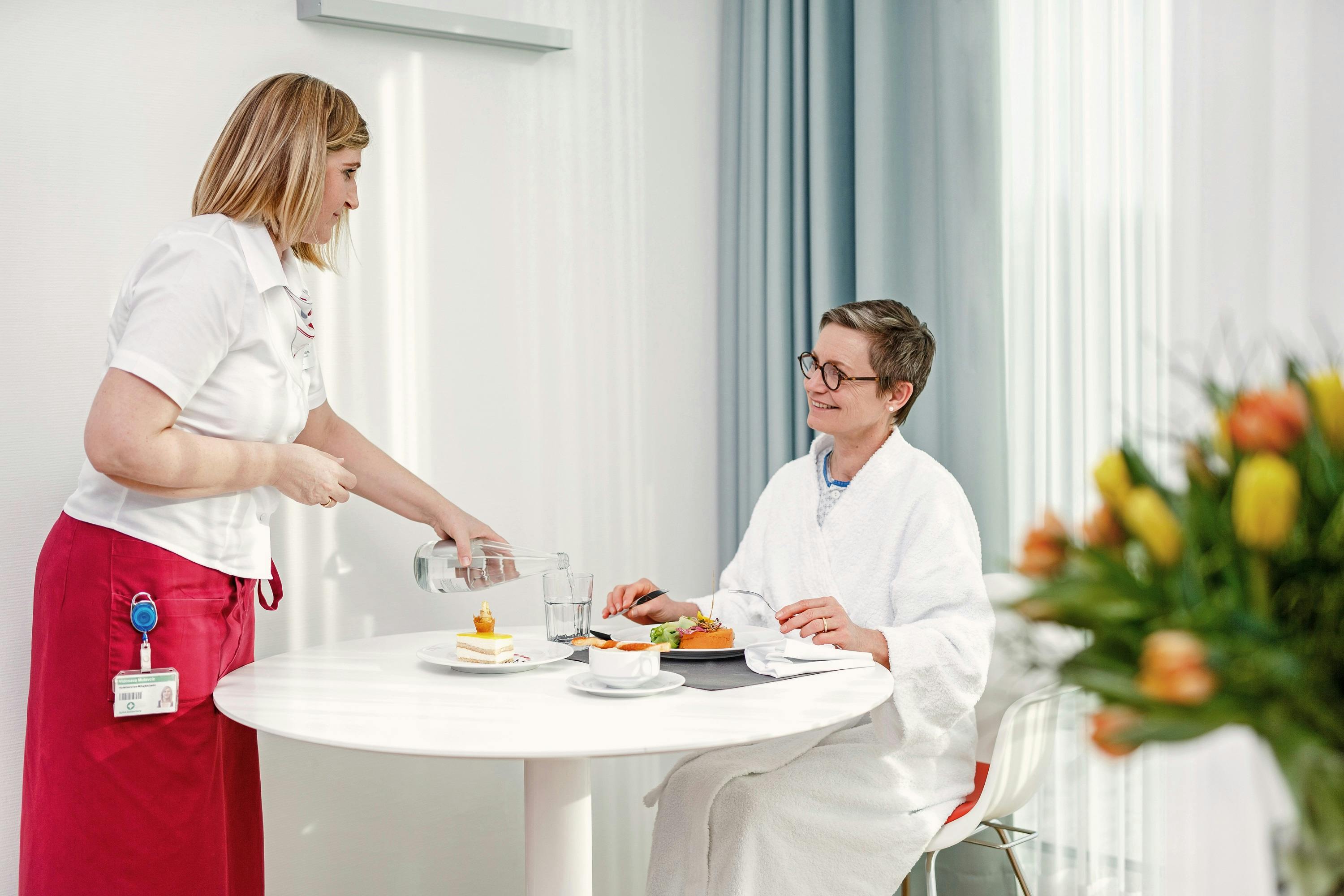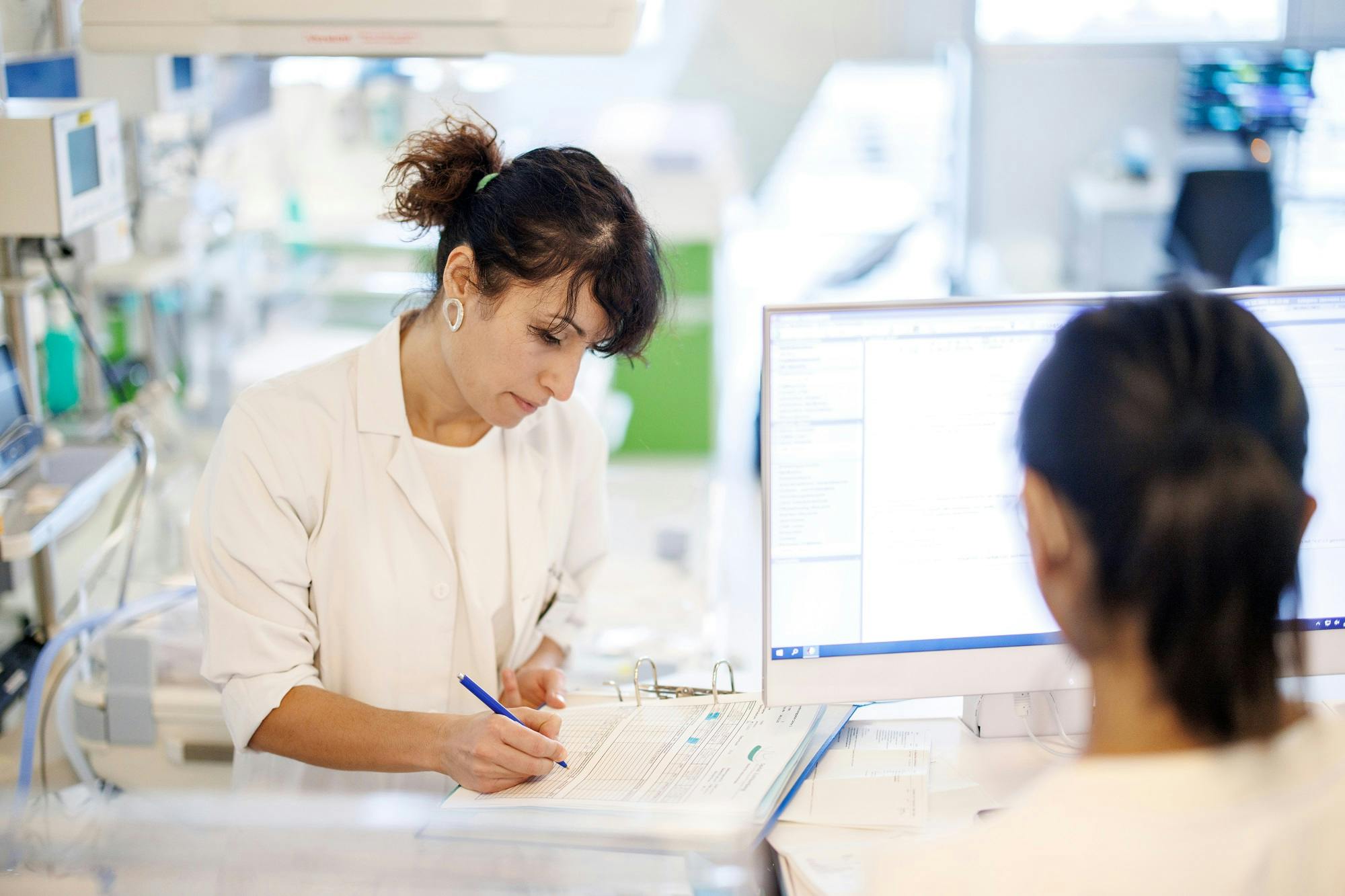Exercises and measures to prevent falls - How you can prevent falls in everyday life
May 28, 2024
6 min
Whether outside in the park or inside your own four walls - the risk of falling, especially for older people, is omnipresent and is often accompanied by a stressful fear of a possible accident. At Zollikerberg Hospital, various experts from different departments support our patients with various approaches to preventing falls. Their common goal is to minimise the risk of falling and help people to walk safely and confidently again.
The body can no longer cope and a fall occurs. How can I prevent this? A central point is the possibility of building up physical fitness. This will be discussed in detail in the rest of this article.
Most falls, especially among older people, are caused by a combination of different factors. "For example, unsteady gait, lack of strength, delirium, medication side effects or external environmental factors," explains Yeliz Bektas, qualified nurse and vocational trainer in acute geriatrics on Private Ward 2 at Zollikerberg Hospital.
There are also special danger spots within your own four walls where you need to be careful, as this is where most falls happen. These are mainly the slippery bathroom and the edges of the dining table. In everyday life, it is therefore important to protect yourself as much as possible and avoid falls.
How can this be done? Your own home can be optimised by ensuring that door thresholds are raised and lighting is appropriate. Carpet bridges should be avoided at all costs. However, carpets in themselves are a good thing, as they can cushion the impact on the floor in the event of a fall, says Yeliz Bektas.
A person can also arm themselves against a fall, for example by minimising unwanted side effects through good medication settings, through physiotherapy, which will be discussed later in the article, and by wearing safe footwear in the home. Yeliz Bektas advises against non-slip socks, as in her experience these can actually become more of a fall risk. "It's more advisable to replace the non-slip socks with normal 'finches'. We do the same here at the hospital and also check our patients' footwear if they don't already do so themselves." Aids that older people in particular need should also be regularly adjusted and optimised. These include glasses, hearing aids and various walking aids, for example. Each of these aids can provide enormous support with gait safety, as they help the person to orientate themselves.
"As an additional aid for our patients in hospital, there are additional safety precautions in the rooms depending on assessment and need, as well as floor mats, seat cushions and an alarm edge," says Yeliz Bektas. Patients can also contact the nursing staff at any time via the call bell if they are unsure, which is checked daily by three different services to ensure that it works around the clock.
Proper nutrition also plays an important role when it comes to preventing falls. A lack of fluids and inadequate nutrition are key risks for falls. Our nutritionists at Zollikerberg Hospital describe the alarming signs of this: "A lack of fluids initially manifests itself with a simple feeling of thirst, but can then increase to confusion and lead to everything from headaches to a decline in mental and physical performance."
The reduced feeling of thirst in old age, forgetfulness or deliberate restriction of oral fluid intake to reduce visits to the toilet also contribute to the risk of dehydration and thus favour the risk of falls. Our nutritionists therefore recommend consuming an optimum of one and a half litres of unsweetened drinks. Sweating or heat increase the need for fluids and should therefore be compensated for by drinking more.
Malnutrition, in particular a lack of energy, protein and vitamin D, can also lead to additional functional losses of the limbs in addition to the natural age-related reduction in muscle mass and therefore represents an increased risk of falling. This risk can be reduced with a needs-covering energy and protein intake, which optimally supports muscle mass and strength, including in the legs. Although the energy requirement decreases with age, the vitamin and mineral requirement remains the same. The protein requirement (protein requirement) is even higher.
Our nutritionists therefore recommend: "Choose nutrient-rich foods. Protein-rich, vitamin- and mineral-rich components should be favoured. Sugar, fat and alcohol-rich components should be reduced. It is therefore essential to include fruit, vegetables and starchy side dishes such as wholemeal bread, potatoes, pasta and polenta along with proteins every day. Fruit and vegetables can be eaten both fresh and frozen."
To cover the increased protein requirement, it is advisable to include a protein source with every main meal, such as dairy products (e.g. cheese or quark), eggs, meat, fish or plant-based options such as pulses (e.g. lentils, chickpeas, red beans), soya in the form of tofu. In addition, you need another portion per day, which can be included as a snack or late meal. This could be, for example, a piece of bread with dried meat or fruit with yoghurt and nuts.
A sufficient intake of calcium and vitamin D is also important to provide optimum support for bones and muscles in old age. However, vitamin D deficiency is possible due to insufficient sunlight in the winter months and the body's reduced ability to produce it. A high level of sun protection (cream) also reduces or prevents the body's own vitamin D production. Food supplements can also be considered here, as our nutritionists explain: "20 micrograms (800 IU) of vitamin D per day is recommended. Discuss this type of vitamin D supplementation with your doctor."
Such a rich diet can therefore counteract the limited freedom of movement and lack of muscle strength that pose major risks for falls. Another way of inhibiting such physical risk factors is active training and building up physical fitness. The therapists at our therapy centre are the right people to contact here. They offer a variety of programmes that are relevant to fall prevention.
For active people aged 50 and over, for example, they offer an "Evergreen" group every Tuesday. "This course trains both muscle strength and balance in a full-body workout," explains Tanja Andres, physiotherapist at our therapy centre. However, participation in this course requires a certain level of basic fitness, as a large proportion of the exercises are performed on the floor.
For older people with less mobility, Tanja Andres recommends using the centre's own well-equipped fitness studio to train their muscles with strength exercises on the equipment. Of course, visitors are not left alone there: "Our specialist staff will provide an introduction to using the equipment and also supervise them while they do the exercises," says Tanja Andres. If necessary, these experts can also specifically address gait insecurities and demonstrate exercises that can then be used. Specific strengthening of the lower extremities is often required, as these play a decisive role in tripping.
If there are people who are no longer able to use the equipment independently, the therapy centre also offers supervised training groups. "If a person is very unsteady in their gait, a physiotherapy prescription for targeted, individually supervised training is helpful. However, this should be discussed in advance with the family doctor," emphasises our physiotherapist.
In order to optimise training that is tailored to individual needs, it is particularly important to draw up a diagnosis as a first step in order to identify the specific difficulties. "To do this, we have fixed tests and scales that we can use to test balance and gait stability," explains Tanja Andres.
Examples include the Berg Balance Scale (BBS), which determines the sense of balance using 14 short practical tests, or the Functional Gait Assessment (FGA), which assesses gait stability. But which systems in the body are actually crucial for balance? "There are three of them. The first is the visual system, the second is the balance organ in the inner ear (vestibular system) and the third is the information from the individual joints and surface receptors of the whole body (somatosensory system)," she explains.
Normally, we humans use around 70 per cent somatosensory, 20 per cent vestibular and 10 per cent visual information for balance when we are standing still. However, in diseases such as polyneuropathy, a disease in which the transmission of stimuli in the body is disturbed, this weighting can shift and thus lead to unsteadiness when walking or standing. There is also a test for this called the Clinical Test for Sensory Interaction in Balance (CTSIB), which can accurately measure such changes.
0/0
General programmes without specific adaptations for the individual person are not useful in such situations and only prevent falls to a limited extent. However, as muscle strength generally decreases, especially in old age, strengthening exercises are almost always part of fall prevention. The therapists work with the patients to determine exactly which exercises to do. Floor training under therapeutic guidance, in which lying down and standing up are practised, can also be useful. It can reduce the fear of falling and of tasks such as picking up objects on the floor.
Exercises to do at home are an important addition to training in courses, in the gym or in individual therapy at our therapy centre. These are usually strengthening or balance exercises. "The treating therapist puts these exercises and their dosage together and adapts the difficulty to the patient's level," says Tanja Andres.
Tanja Andres has further tips for minimising the risk of tripping in everyday life at home: You should install a good light, remove carpets and also wear suitable footwear in the home. If necessary, it is also a good idea to use an assistive device, for which you can seek advice from your physiotherapist. An emergency call button can also be useful in the event of a fall. "Finally, regular checks of visual aids such as glasses or contact lenses are also important, as visual problems can also lead to falls," emphasises the physiotherapist.
Weitere Beiträge
Counsellor
Hormone fluctuations in winter: What's really behind them?
Many women experience changes in their physical and mental well-being in winter. They feel tired more often, less resilient or more emotionally sensitive. Cycle changes or more intense premenstrual symptoms are also noticed more often during this time. In addition to external factors such as the cold, less exercise or a change in lifestyle, hormonal processes can also play a role.
Counsellor
Spinal surgery: everything you need to know
At Zollikerberg Hospital, the highest precision applies to one of the most central and at the same time most demanding areas of the body - the spine. Spinal surgery here means not only modern, minimally invasive technology, but above all sound expertise, experience and careful, holistic care. This is what Dr Filippo Mandelli, Head of the Spinal Surgery Clinic, and his team stand for. They treat conditions such as herniated discs, spinal canal stenosis, spondylolisthesis, spinal deformities and degenerative changes competently and sensitively and accompany patients on their way to greater stability and quality of life. In this interview, you can find out what is particularly important in these complex interventions - and what modern spinal medicine can achieve today.
Counsellor
Eyelid lift (blepharoplasty) for drooping eyelids - a brief overview
The eyes are the mirror of our soul - and yet drooping eyelids, bags under the eyes or sagging skin on the eyelid can leave a tired and older impression. If you would like to regain an alert, fresh look, an eyelid lift (blepharoplasty) at Zurich Plastic Surgery can help. In this blog post, Prof Dr Hisham Fansa, Head of Plastic Surgery Zurich, explains why many people decide to have their drooping eyelids corrected and what is important during this procedure.


